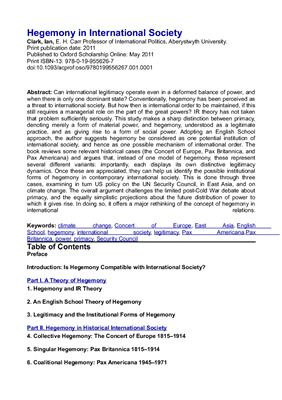Oxford University Press. 2011. 285 p.
Can inteational legitimacy operate even in a deformed balance of power, and when there is only one dominant state? Conventionally, hegemony has been perceived as a threat to inteational society. But how then is inteational order to be maintained, if this still requires a managerial role on the part of the great powers? IR theory has not taken that problem sufficiently seriously. This study makes a sharp distinction between primacy, denoting merely a form of material power, and hegemony, understood as a legitimate practice, and as giving rise to a form of social power. Adopting an English School approach, the author suggests hegemony be considered as one potential institution of inteational society, and hence as one possible mechanism of inteational order. The book reviews some relevant historical cases (the Concert of Europe, Pax Britannica, and Pax Americana) and argues that, instead of one model of hegemony, these represent several different variants: importantly, each displays its own distinctive legitimacy dynamics. Once these are appreciated, they can help us identify the possible institutional forms of hegemony in contemporary inteational society. This is done through three cases, examining in tu US policy on the UN Security Council, in East Asia, and on climate change. The overall argument challenges the limited post-Cold War debate about primacy, and the equally simplistic projections about the future distribution of power to which it gives rise. In doing so, it offers a major rethinking of the concept of hegemony in inteational relations.
Table of Contents
Preface
Introduction: Is Hegemony Compatible with Inteational Society?
Part I. A Theory of Hegemony
1. Hegemony and IR Theory
2. An English School Theory of Hegemony
3. Legitimacy and the Institutional Forms of Hegemony
Part II. Hegemony in Historical Inteational Society
4. Collective Hegemony: The Concert of Europe 1815–1914
5. Singular Hegemony: Pax Britannica 1815–1914
6. Coalitional Hegemony: Pax Americana 1945–1971
Part III. Hegemony in Contemporary Inteational Society
7. Hegemony in Inteational Organization: The UN Security Council
8. Hegemony in Regional Order: East Asia
9. Hegemony in Inteational Policy: The Climate Change Regime
Conclusion: The United States in Inteational Society
Bibliography
Can inteational legitimacy operate even in a deformed balance of power, and when there is only one dominant state? Conventionally, hegemony has been perceived as a threat to inteational society. But how then is inteational order to be maintained, if this still requires a managerial role on the part of the great powers? IR theory has not taken that problem sufficiently seriously. This study makes a sharp distinction between primacy, denoting merely a form of material power, and hegemony, understood as a legitimate practice, and as giving rise to a form of social power. Adopting an English School approach, the author suggests hegemony be considered as one potential institution of inteational society, and hence as one possible mechanism of inteational order. The book reviews some relevant historical cases (the Concert of Europe, Pax Britannica, and Pax Americana) and argues that, instead of one model of hegemony, these represent several different variants: importantly, each displays its own distinctive legitimacy dynamics. Once these are appreciated, they can help us identify the possible institutional forms of hegemony in contemporary inteational society. This is done through three cases, examining in tu US policy on the UN Security Council, in East Asia, and on climate change. The overall argument challenges the limited post-Cold War debate about primacy, and the equally simplistic projections about the future distribution of power to which it gives rise. In doing so, it offers a major rethinking of the concept of hegemony in inteational relations.
Table of Contents
Preface
Introduction: Is Hegemony Compatible with Inteational Society?
Part I. A Theory of Hegemony
1. Hegemony and IR Theory
2. An English School Theory of Hegemony
3. Legitimacy and the Institutional Forms of Hegemony
Part II. Hegemony in Historical Inteational Society
4. Collective Hegemony: The Concert of Europe 1815–1914
5. Singular Hegemony: Pax Britannica 1815–1914
6. Coalitional Hegemony: Pax Americana 1945–1971
Part III. Hegemony in Contemporary Inteational Society
7. Hegemony in Inteational Organization: The UN Security Council
8. Hegemony in Regional Order: East Asia
9. Hegemony in Inteational Policy: The Climate Change Regime
Conclusion: The United States in Inteational Society
Bibliography

